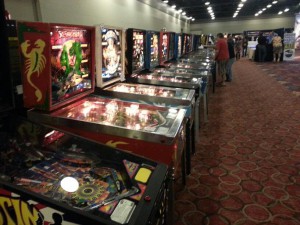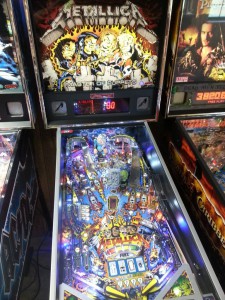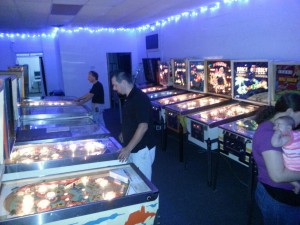Recently someone on a local mailing list posed these questions:
Hi all. I am looking to purchase my first pinball machine. I am specifically wondering about:
(1) Should I buy new or used
(2) Ebay and/or Craig’s list okay to buy from? or stick to this list and vendors?
(3) How much maintenance is generally required in a less than 10 year old pin?
(4) Is it best to start with a machine with less moving parts ? or does that not matter?
(5) Do I only buy pins listed as home use only or is there a way to get around the coin option? I am assuming there must be a free play setting.
(6) Can you fit a pin in a large SUV? or do you need a truck?
(7) What else do I need to know?
Thanks in advance for helping the newbie. 🙂
Those are some great questions so I thought I’d address them here.
First… Should I buy new or used?

The first consideration when purchasing a pinball machine is: How much money are you willing to spend? I would say, before that, you have an idea of what type of game you want? Are you into older, slower-paced electro-mechanical-style games or more modern gameplay? The amount of money you have available will also determine this direction.
Obviously, if someone is looking to get into the hobby for under $3000-$4000, there is only one answer: Buy used (with a few exceptions such as certain games like the repro King of Diamonds, or “consumer-grade/home-style” pinball machines, etc.). Modern commercial pinball machines are typically priced in the $3500+ range. Also, the newer the game is, the more expensive it’s likely to be. Later-model used games are now going for $4000+, so be prepared to give that checkbook some airtime if you’re looking for a late-model, modern game.
Typically, pinball enthusiasts fall into a few basic categories: people who like working on games, people who like working on and playing games, and people who mainly like playing games. Yes, there are some people who spend more time fixing and restoring games than they do playing — there’s a fourth category of what are called “flippers” which are people who are mainly into buying and selling but I consider them “salesmen” and not “pinball enthusiasts.” They have a lot of games, but they’re in it for the money. So you have to decide to what degree you may be interested in doing work on a game. The general rule is: the older the game, the more maintenance/work may be required to get it running and keep it running. This is not always a consistent rule. There are some modern games that are high maintenance and some old games that are very reliable – when you find something you’re interested in, do your research and read up on it (especially at ipdb.com).
People that are mainly into playing games and don’t have time or interest in working on them are best served by buying either late-model or NIB (new-in-box) games. Although I have to warn you, no matter how disinterested you are in having to work on a pinball machine, you will end up doing some maintenance. It’s the nature of the beast. Many people find out they enjoy working on the games as much as they do playing them.
If you have the time and the interest, buying a used game is the best deal. However, just deciding you want to get a used game is the first step. How you acquire the game, what game you choose, etc. will determine whether the process is fun or fraught with frustration. Which brings us to your next question:
Ebay and/or Craig’s list okay to buy from? or stick to mailing enthusiast groups and vendors?
For a first-time buyer, I would advise against using Craigslist or Ebay to purchase games.
EBay is too risky, especially if you’re having a game shipped. EBay games will often be sold “as-is.” Too much can happen to the game in transit and it’s easy to have a conflict between the buyer and seller and have the money get tied up over a dispute. Craigslist is also iffy because it’s the most common source where sellers misrepresent the condition of games, or simply don’t know and as a first-timer, you end up buying blind, not knowing the actual condition of the game. Also, Craiglist people cover a wide spectrum from flippers to enthusiasts to people who have just seen some “pickers”-type show on TV and think their game is worth 10x the fair market value. It’s not a place you should look to as a first-time buyer. It’s very easy to end up with a lemon or overspend.
 Vendors/Distributors are the way to go for new games. But note that vendors, if they sell used games, will often sell them way above market value, but if you want some kind of service agreement, they may offer the only option. As in every case, do some research and ask around about the seller/vendor’s reputation.
Vendors/Distributors are the way to go for new games. But note that vendors, if they sell used games, will often sell them way above market value, but if you want some kind of service agreement, they may offer the only option. As in every case, do some research and ask around about the seller/vendor’s reputation.
Other pinball enthusiasts are often the best source of games for newbies. Many love to introduce new people to the hobby. The best place IMO to pick up a game for a first timer at a good price, is at one of the pinball conventions. (In our area, there’s the Houston Arcade Expo and the Texas Pinball Festival in Dallas) These annual events often bring large groups of games for sale that in many cases were lovingly maintained by collectors. Plus you get a chance to play on the games and have other enthusiasts comment on whether the game and the deal is good.
How much maintenance is generally required in a less than 10 year old pin?
Is it best to start with a machine with less moving parts ? or does that not matter?
That’s a tough question, and there are no consistent answers. The amount of maintenance can vary based on dozens of factors (not the least of which is luck/fate), including the past history of the machine and how much play it’s seen, how well it was previously maintained, the particular model and whether it has any troublesome components, etc. Some manufacturers are more or less difficult to find parts for (Bally/Williams and Stern have the most parts available, followed by Gottlieb, and other manufacturers may have replacement parts less available – so take that into account if you decided to look at a Capcom, Game Plan or Chicago Coin machine).
 I’ve seen situations where NIB games required more maintenance than 40 year old ones. You have to ask the seller/owner on a game-by-game basis. However, some architectures are more reliable than others. Williams System 3 games have some issues. Gottlieb System 1 games have some issue but they can be mitigated with some modifications, etc. Do your research and see if common problems have already been addressed (like adding remote battery holders on games). Find out if any particular playfield part commonly malfunctions or balls get stuck on certain machines. If reliability is an issue, this may point you away from particular machines that have lots of moving components that aren’t well-designed.
I’ve seen situations where NIB games required more maintenance than 40 year old ones. You have to ask the seller/owner on a game-by-game basis. However, some architectures are more reliable than others. Williams System 3 games have some issues. Gottlieb System 1 games have some issue but they can be mitigated with some modifications, etc. Do your research and see if common problems have already been addressed (like adding remote battery holders on games). Find out if any particular playfield part commonly malfunctions or balls get stuck on certain machines. If reliability is an issue, this may point you away from particular machines that have lots of moving components that aren’t well-designed.
Do I only buy pins listed as home use only or is there a way to get around the coin option? I am assuming there must be a free play setting.
“Home Use Only” is a very ambiguous term. Take it with a grain of salt. Unless the seller has documentation proving he purchased the game and it was never used commercially, there’s no way to know, and furthermore, HUO doesn’t necessarily mean the game is in better-condition than something that was put on route. It all depends upon how the owner cared for the game. I’ve seen HUO games that were ruined, water-damaged, full of cat hair and in horrible condition, and I’ve seen heavily-routed games that were imported from foreign countries that look gorgeous for their age.
Most modern games can be set to free play. Many of the older EM games didn’t have a free-play setting but it’s not too difficult to add a jumper to make them play for free. That’s not a problem. Most people like to keep the coin mechs in the games, and some of us even like to make the games “pay for play” like they originally were. Having to find a quarter to play a game makes each game session a little more important IMO.
Can you fit a pin in a large SUV? or do you need a truck?
Yes, most SUVs can fit a pinball machine – depending upon the model, but most of them can – but once again, check your model. The ones with a back seat where the seats can fold down are quite roomy. I have a Toyota 4Runner that I use as my principle pin-hauling machine and it works great.
What else do I need to know?
Get to know the local pinball people in your area. Spend time with them. The more games you play, the more you’ll know what you like and what will be a good deal. Unfortunately most pinball people end up paying too much for their first game, or getting a game that is harder to maintain than they’d like, so the more research you know, and if you have a friend who can help you out who knows more, that’s great. Sites like PinballHelp.com also have various resources. I have a large array of videos on repair and maintenance, lists of sources for pinball parts and items to clean and maintain your game, and other helpful hints. Other places like Pinside and RGP are good for researching particular games and technical issues.
Good luck with your first game!!



